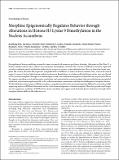| dc.contributor.author | Sun, Hao Sheng | |
| dc.contributor.author | Maze, Ian | |
| dc.contributor.author | Dietz, David M. | |
| dc.contributor.author | Scobie, Kimberly N. | |
| dc.contributor.author | Kennedy, Pamela J. | |
| dc.contributor.author | Damez-Werno, Diane | |
| dc.contributor.author | Neve, Rachael L. | |
| dc.contributor.author | Zachario, Venetia | |
| dc.contributor.author | Shen, Li | |
| dc.contributor.author | Nestler, Eric J. | |
| dc.date.accessioned | 2013-06-20T15:45:21Z | |
| dc.date.available | 2013-06-20T15:45:21Z | |
| dc.date.issued | 2012-11 | |
| dc.date.submitted | 2012-10 | |
| dc.identifier.issn | 0270-6474 | |
| dc.identifier.issn | 1529-2401 | |
| dc.identifier.uri | http://hdl.handle.net/1721.1/79352 | |
| dc.description.abstract | Dysregulation of histone modifying enzymes has been associated with numerous psychiatric disorders. Alterations in G9a (Ehmt2), a histone methyltransferase that catalyzes the euchromatic dimethylation of histone H3 at lysine 9 (H3K9me2), has been implicated recently in mediating neural and behavioral plasticity in response to chronic cocaine administration. Here, we show that chronic morphine, like cocaine, decreases G9a expression, and global levels of H3K9me2, in mouse nucleus accumbens (NAc), a key brain reward region. In contrast, levels of other histone methyltransferases or demethylases, or of other methylated histone marks, were not affected in NAc by chronic morphine. Through viral-mediated gene transfer and conditional mutagenesis, we found that overexpression of G9a in NAc opposes morphine reward and locomotor sensitization and concomitantly promotes analgesic tolerance and naloxone-precipitated withdrawal, whereas downregulation of G9a in NAc enhances locomotor sensitization and delays the development of analgesic tolerance. We identified downstream targets of G9a by providing a comprehensive chromatin immunoprecipitation followed by massively parallel sequencing analysis of H3K9me2 distribution in NAc in the absence and presence of chronic morphine. These data provide novel insight into the epigenomic regulation of H3K9me2 by chronic morphine and suggest novel chromatin-based mechanisms through which morphine-induced addictive-like behaviors arise. | en_US |
| dc.language.iso | en_US | |
| dc.publisher | Society for Neuroscience | en_US |
| dc.relation.isversionof | http://dx.doi.org/10.1523/jneurosci.1357-12.2012 | en_US |
| dc.rights | Article is made available in accordance with the publisher's policy and may be subject to US copyright law. Please refer to the publisher's site for terms of use. | en_US |
| dc.source | SFN | en_US |
| dc.title | Morphine Epigenomically Regulates Behavior through Alterations in Histone H3 Lysine 9 Dimethylation in the Nucleus Accumbens | en_US |
| dc.type | Article | en_US |
| dc.identifier.citation | Sun, H., I. Maze, D. M. Dietz, K. N. Scobie, P. J. Kennedy, D. Damez-Werno, R. L. Neve, V. Zachariou, L. Shen, and E. J. Nestler. Morphine Epigenomically Regulates Behavior Through Alterations in Histone H3 Lysine 9 Dimethylation in the Nucleus Accumbens. Journal of Neuroscience 32, no. 48 (November 28, 2012): 17454-17464. | en_US |
| dc.contributor.department | Massachusetts Institute of Technology. Department of Brain and Cognitive Sciences | en_US |
| dc.contributor.mitauthor | Neve, Rachael L. | en_US |
| dc.relation.journal | Journal of Neuroscience | en_US |
| dc.eprint.version | Final published version | en_US |
| dc.type.uri | http://purl.org/eprint/type/JournalArticle | en_US |
| eprint.status | http://purl.org/eprint/status/PeerReviewed | en_US |
| dspace.orderedauthors | Sun, H.; Maze, I.; Dietz, D. M.; Scobie, K. N.; Kennedy, P. J.; Damez-Werno, D.; Neve, R. L.; Zachariou, V.; Shen, L.; Nestler, E. J. | en_US |
| dc.identifier.orcid | https://orcid.org/0000-0002-3854-5968 | |
| mit.license | PUBLISHER_POLICY | en_US |
| mit.metadata.status | Complete | |
